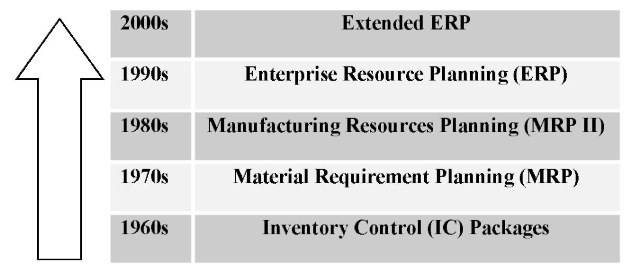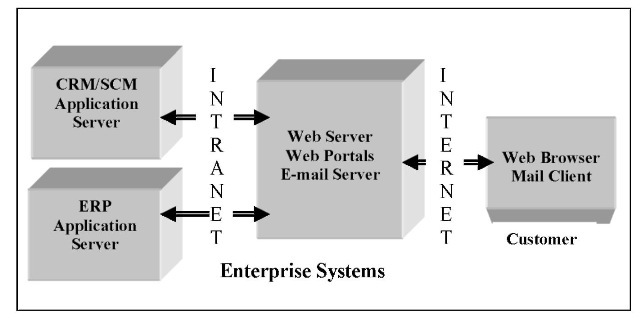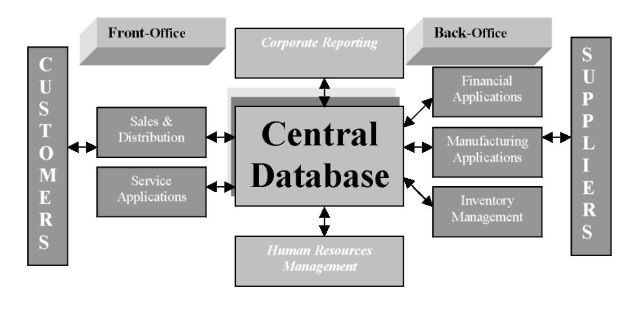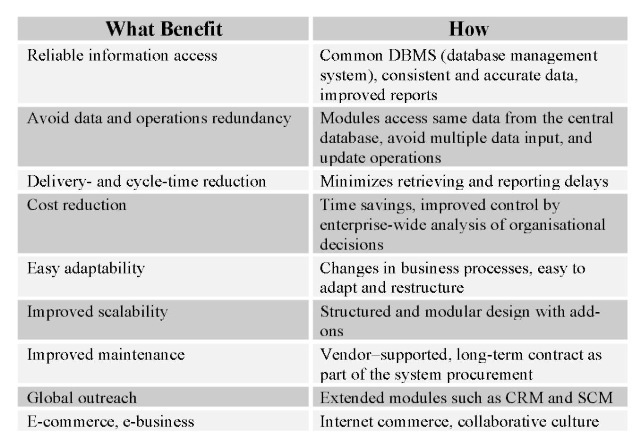INTRODUCTION
The functional units of today’s complex business environment require more and more interfunctional data flow for decision making, timely and efficient procurement of product parts, management of inventory, accounting, human resources, and distribution of goods and services. Management of such organizations need efficient information systems to improve competitiveness by cost reduction and better logistics. Enterprise resource-planning systems (ERP), or enterprise systems (Brady, Monk, & Wagner, 2001; Grant, 2003; Hamilton, 2002; Hossain, Patrick, & Rashid, 2002; O’Leary, 2000), are such software systems for business management encompassing modules supporting functional areas such as planning, manufacturing, sales, marketing, distribution, accounting, finances, human resource management, project management, inventory management, service and maintenance, transportation, and e-business. The architecture of the software facilitates transparent integration of modules providing flow of information between all functions within the enterprise in a consistently visible manner. Corporate computing with ERPs allows companies to implement a single integrated system by replacing or reengineering their mostly incompatible legacy information systems.
The concept of the ERP system as “one database, one application and a unified interface across the entire enterprise” (Tadjer, 1998) can be illustrated, following Davenport (1998), with the diagram in Figure 1. The American Production and Inventory Control Society (APICS, 2001) has defined ERP systems as “a method for the effective planning and controlling of all the resources needed to take, make, ship and account for customer orders in a manufacturing, distribution or service company.” An ERP system “comprises of a commercial software package that promises the seamless integration of all the information flowing through the company—financial, accounting, human resources, supply chain and customer information” (Davenport, 1998). They are “configurable information systems packages that integrate information and information-based processes within and across functional areas in an organisation” (Kumar & Van Hillsgersberg, 2000).
ERP systems surfaced in the market in the late 1980s and the beginning of the 1990s, targeting mainly large complex business organizations. During the 1960s, most organisations designed, developed, and implemented centralised computing systems, mostly automating their inventory control systems using inventory control (IC) packages. Material requirements planning (MRP) systems were developed in the 1970s and involved mainly planning the product or parts requirements according to the master production schedule. Following this route, new software systems called manufacturing resources planning (MRP II) were introduced in the 1980s with an emphasis on optimizing manufacturing processes by synchronising the materials with production requirements. MRP II included areas such as shop floor and distribution management, project management, finance, human resource, and engineering. Based on the technological foundations of MRP and MRP II, ERP systems integrate business processes including manufacturing, distribution, accounting, finances, human resource management, project management, inventory management, service and maintenance, transportation providing accessibility, visibility, and consistency across the enterprise.
Figure I. ERP systems concept
Figure 2. ERP evolution

During the 1990s, ERP vendors added more modules and functions as “add-ons” to the core modules, giving birth to the “extended ERPs.” These ERP extensions include advanced planning and scheduling (APS), ebusiness solutions such as customer relationship management (CRM), and supply chain management (SCM). Figure 2 summarises the historical events related with ERP.
Organisations choose and deploy ERP systems for many tangible and intangible benefits and strategic reasons. In many cases, the calculation of return on investment (ROI) is weighted against the many intangible and strategic benefits. The benefits that an ERP system may bring to organizations are shown in Table 1 while Table 2 shows the problems and disadvantages organisations need to overcome to reap the benefits.
Table 1. Advantages of ERP systems
Table 2. Disadvantages of ERP systems

An ERP system is required to have the following characterisitics:
• Modular design comprising many distinct business modules.
• Use centralized common database management system (DBMS).
• The modules are integrated and provide seamless dataflow.
• They are generally complex systems involving high cost.
• They are flexible and offer best business practices.
• They require time-consuming tailoring and configuration setups.
• The modules work in real-time: on-line and batch processing capabilities.
• They are or soon they will be Internet-enabled.
Different ERP vendors provide ERP systems with some degree of specialty, but the core modules are almost the same for all of them. Some of the core ERP modules found in the successful ERP systems is the following.
• Accounting management
• Financial management
• Manufacturing management
• Production management
• Transportation management
• Sales and distribution management
• Human resources management
• Supply chain management
• Customer relationship management
• E-business
COMMERCIAL ERP SYSTEMS
The dominating ERP software suppliers in 2003 were SAP, PeopleSoft, Oracle, SSA Global, Microsoft, and Sage. According to IDC (International Data Corp), the top-ten vendors in 2003 had a market share of 46% of the $25 billion ERP market. Each vendor, due to historic reasons, has a specialty in one particular module area such as SAP in logistics, PeopleSoft in human resources management, Oracle in financials, and SSA Global’s SSA Baan ERP in manufacturing. There are also about 50 established and a few more newly emerging smaller and midsize ERP vendors and third-party developers competing for the ERP market. The result is stiff competition and feature-overlapping products difficult to differentiate. Long-term vision, commitment to service and support, module features, specialty, experience, and financial strength for R&D are the major vendor qualities for product selection and turnkey implementation. Table 3 shows the brief profile of these dominating ERP vendors.
Table 3. Brief profile of the dominating ERP vendors

The continued growth of the ERP systems market is attributed to the fact that the vendors are adding applications such as supply chain management, customer relationship management, and the integration of Internet-enabled applications for e-business. ERP vendors are targeting the untapped SME (small and medium-sized enterprise) market with supposedly scaled-back systems suitable for smaller firms by offering simple, cheaper, and preconfigured, easy-to-install solutions within budget and time constraints. For some vendors, this may lead to offering centrally managed, Internet-enabled, ERP-sys-tem-based services for SMEs to access and use anytime from anywhere.
ERP systems are becoming more and more Internet-enabled (Lawton, 2000), extending legacy ERP systems to integrate with newer external business modules such as supply chain management, customer relationship management, sales-force automation (SFA), advanced planning and scheduling, business intelligence (BI), and ebusiness capabilities. In fact, ERP is becoming the ebusiness backbone for organisations doing online business transactions over the Internet. Adoption of e-commerce and e-business solutions, especially business-to-business (B2B) solutions, is seen by many as the wave of current and future extensions of traditional ERP systems of most small, medium, and large vendors. The front-end, Web-based Internet-business applications are integrated with the back-office, ERP-based applications enabling business transactions such as order placement, purchasing, inventory updates, employee benefits, and so forth to take place between the customers, suppliers, and the enterprise based on reliable, relevant data and applications instantly in a borderless domain. Examples of such Internet-enabled, extended ERPs are available from most of the ERP vendors. The concept of the Internet-enabled, extended ERP system is shown in Figure 3.
CONCLUSION
The unprecedented growth of computing power and the proliferation of the Internet brings new challenges to ERP vendors for redesigning their products, breaking the barrier of proprietorship and customisation, and embracing the collaborative business over intranet, extranet, and the Internet in a seamless manner. A sign of acceptance of these challenges is the appearance of new add-on modules that follow open architecture, provide interchangeable modules, and allow easy customisation and user interfacing.
Figure 3. Web-enabled extended ERP system

There are scopes for emerging ERP vendors to contribute to the field, especially in the aerospace industry, the finance industry, and the logistics industry. Analysis of the market penetration of ERP systems shows clearly that the current players have to downsize their products and offerings to be attractive to SMEs. Changes in ERP software architecture taking advantage of the smaller but powerful hardware platforms can provide significant opportunities to smaller players to bring new small, robust, easy-to-use systems into the market suitable for SMEs. Future successful vendors will capture large markets of smaller businesses by providing a more consistent and enduring income stream.
KEY TERMS
APICS: American Production and Inventory Control Society. A not-for-profit international, educational organization founded in 1957, respected throughout the world for its education and professional certification programs.
Customer Relationship Management (CRM): Software systems that help companies to acquire knowledge about customers and deploy strategic information systems to optimize revenue, profitability, and customer satisfaction
Extended ERP: Extends the foundation ERP system’s functionalities such as finances, distribution, manufacturing, human resources, and payroll to customer relationship management, supply chain management, sales-force automation, and Internet-enabled integrated e-com-merce and e-business
Fat Client/Server Architecture (C/S): A client/server network architecture where the client (PCs or workstations on which users run applications) performs the bulk of the data-processing operations while the data itself is stored on the server
Graphical User Interface (GUI): A software interface based on the computer’s graphics capabilities with pointing devices such as the mouse that free the user from learning complex commands for using programs
Return On Investment (ROI): An estimate expressed as a ratio comparing the net benefits (the “return”) to its total cost (the “investment”) for measuring operating performance and efficiency in utilizing the assets of the company
Small and Medium-Sized Enterprise (SME): A business enterprise independently owned by contributing most of the operating capital and managed by the owners or managers, having fewer than 250 employees and a small-to-medium market share
Supply Chain Management (SCM): Software systems for procurement of materials, transformation of the materials into products, and distribution of products to customers, allowing the enterprise to anticipate demand and deliver the right product to the right place at the right time at the lowest possible cost to satisfy its customers


